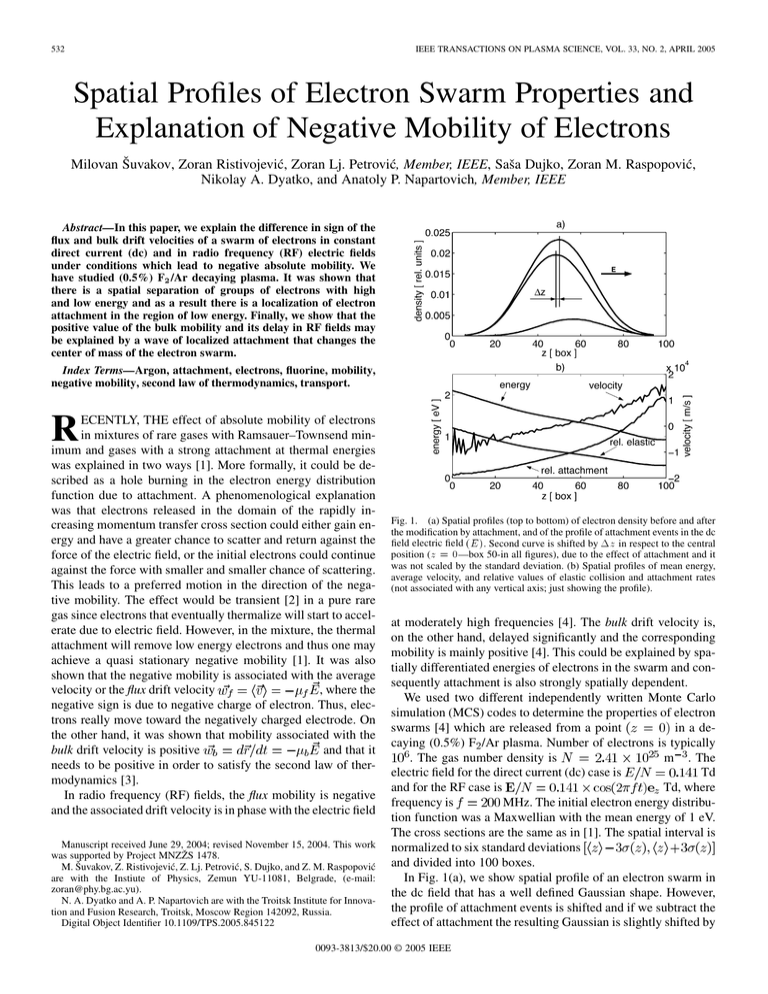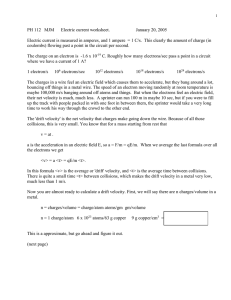- Institute of Physics Belgrade Roundcube Webmail
advertisement

532 IEEE TRANSACTIONS ON PLASMA SCIENCE, VOL. 33, NO. 2, APRIL 2005 Spatial Profiles of Electron Swarm Properties and Explanation of Negative Mobility of Electrons Milovan Šuvakov, Zoran Ristivojević, Zoran Lj. Petrović, Member, IEEE, Saša Dujko, Zoran M. Raspopović, Nikolay A. Dyatko, and Anatoly P. Napartovich, Member, IEEE Abstract—In this paper, we explain the difference in sign of the flux and bulk drift velocities of a swarm of electrons in constant direct current (dc) and in radio frequency (RF) electric fields under conditions which lead to negative absolute mobility. We have studied (0.5%) F2 /Ar decaying plasma. It was shown that there is a spatial separation of groups of electrons with high and low energy and as a result there is a localization of electron attachment in the region of low energy. Finally, we show that the positive value of the bulk mobility and its delay in RF fields may be explained by a wave of localized attachment that changes the center of mass of the electron swarm. Index Terms—Argon, attachment, electrons, fluorine, mobility, negative mobility, second law of thermodynamics, transport. R ECENTLY, THE effect of absolute mobility of electrons in mixtures of rare gases with Ramsauer–Townsend minimum and gases with a strong attachment at thermal energies was explained in two ways [1]. More formally, it could be described as a hole burning in the electron energy distribution function due to attachment. A phenomenological explanation was that electrons released in the domain of the rapidly increasing momentum transfer cross section could either gain energy and have a greater chance to scatter and return against the force of the electric field, or the initial electrons could continue against the force with smaller and smaller chance of scattering. This leads to a preferred motion in the direction of the negative mobility. The effect would be transient [2] in a pure rare gas since electrons that eventually thermalize will start to accelerate due to electric field. However, in the mixture, the thermal attachment will remove low energy electrons and thus one may achieve a quasi stationary negative mobility [1]. It was also shown that the negative mobility is associated with the average , where the velocity or the flux drift velocity negative sign is due to negative charge of electron. Thus, electrons really move toward the negatively charged electrode. On the other hand, it was shown that mobility associated with the and that it bulk drift velocity is positive needs to be positive in order to satisfy the second law of thermodynamics [3]. In radio frequency (RF) fields, the flux mobility is negative and the associated drift velocity is in phase with the electric field Manuscript received June 29, 2004; revised November 15, 2004. This work was supported by Project MNZŽS 1478. M. Šuvakov, Z. Ristivojević, Z. Lj. Petrović, S. Dujko, and Z. M. Raspopović are with the Instiute of Physics, Zemun YU-11081, Belgrade, (e-mail: zoran@phy.bg.ac.yu). N. A. Dyatko and A. P. Napartovich are with the Troitsk Institute for Innovation and Fusion Research, Troitsk, Moscow Region 142092, Russia. Digital Object Identifier 10.1109/TPS.2005.845122 Fig. 1. (a) Spatial profiles (top to bottom) of electron density before and after the modification by attachment, and of the profile of attachment events in the dc field electric field E . Second curve is shifted by z in respect to the central position (z —box 50-in all figures), due to the effect of attachment and it was not scaled by the standard deviation. (b) Spatial profiles of mean energy, average velocity, and relative values of elastic collision and attachment rates (not associated with any vertical axis; just showing the profile). =0 ( ) 1 at moderately high frequencies [4]. The bulk drift velocity is, on the other hand, delayed significantly and the corresponding mobility is mainly positive [4]. This could be explained by spatially differentiated energies of electrons in the swarm and consequently attachment is also strongly spatially dependent. We used two different independently written Monte Carlo simulation (MCS) codes to determine the properties of electron in a deswarms [4] which are released from a point caying (0.5%) F /Ar plasma. Number of electrons is typically . The gas number density is m . The Td electric field for the direct current (dc) case is Td, where and for the RF case is MHz. The initial electron energy distribufrequency is tion function was a Maxwellian with the mean energy of 1 eV. The cross sections are the same as in [1]. The spatial interval is normalized to six standard deviations and divided into 100 boxes. In Fig. 1(a), we show spatial profile of an electron swarm in the dc field that has a well defined Gaussian shape. However, the profile of attachment events is shifted and if we subtract the effect of attachment the resulting Gaussian is slightly shifted by 0093-3813/$20.00 © 2005 IEEE ŠUVAKOV et al.: SPATIAL PROFILES OF ELECTRON SWARM PROPERTIES AND EXPLANATION OF NEGATIVE MOBILITY OF ELECTRONS Fig. 2. 533 MCS results in RF fields: (a) time (phase) profiles of drift velocities; space-time profiles of (b) average velocity; (c) mean energy, and (d) attachment rate. . The shift is roughly equivalent to the drift velocity of 15 500 m/s which is in a reasonable agreement with the calculated bulk m/s. Thus, we may conclude that the drift velocity bulk drift velocity is the result of the shift of the center of mass due to attachment wave that is spatially dependent. In Fig. 1(b), we show spatial profiles of swarm properties. We see that the mean energy is strongly spatially dependent and that the attachment rate peaks in the low-energy region. At the same time, it is important to note that the flux drift velocity which on average has a negative mobility (positive value in this figure as the direction of the force is to the left) is also spatially separated into two regions with mean velocities in opposite directions. The separation into two regions with opposite directions of velocity is unexpected but, overall, the results give support to the explanation that spatially localized attachment results in the opposite signs of the flux and bulk drift velocity. For RF fields, we sampled the time dependence of spatially resolved flux and bulk drift velocities and of different rate coefficients. All quantities that depend on time are sampled in 100 points per period and over several periods until sufficiently good statistics was achieved. In Fig. 2(a), we show the drift velocities and in Fig. 2(b), the spatial profile of the average velocity. One should note that for all times there are two spatially isolated groups of electrons with different directions positive and negative. There is only a small modulation leading to time dependence of the flux drift velocity. In gases with positive mo- bility, the entire velocity profile changes sign as field changes direction. The mean energy shown in Fig. 2(c) is strongly modulated. . Spatial proRelaxation of the energy has a delay time of file of attachment, shown in Fig. 2(d), has modulation opposite to that of the energy, it peaks at low energies and its temporal profile coincides with that of the bulk drift velocity. At smaller . frequencies, the phase difference is less than The results are consistent with the explanation that the bulk drift velocity is the result of a wave of attachment changing the spatial profile of electrons. The most surprising result is however that there is little modulation of the average velocity with two spatially isolated groups with velocities in two opposite directions. REFERENCES [1] N. A. Dyatko, A. P. Napartovich, S. Sakadžic, Z. Lj. Petrović, and Z. M. Raspopović, “On the possibility of negative electron mobility in a decaying plasma,” J. Phys. D, Appl. Phys., vol. 33, pp. 375–380, 2000. [2] J. M. Warman, U. Sowada, and M. P. De Haas, “Transient negative mobility of hot electrons in gaseous xenon,” Phys. Rev. A, Gen. Phys., vol. 31, pp. 1974–1976, 1985. [3] R. E. Robson, Z. Lj. Petrović, Z. M. Raspopović, and D. Loffhagen, “Negative absolute electron mobility, Joule cooling, and the second law,” J. Chem. Phys., vol. 119, no. 21, pp. 11 249–11 252, 2003. [4] S. Dujko, Z. M. Raspopovic, Z. Lj. Petrovic, and T. Makabe, “Negative mobilities of electrons in radio frequency fields,” IEEE Trans. Plasma Sci. , vol. 31, no. 4, pp. 711–716, Aug. 2003.


